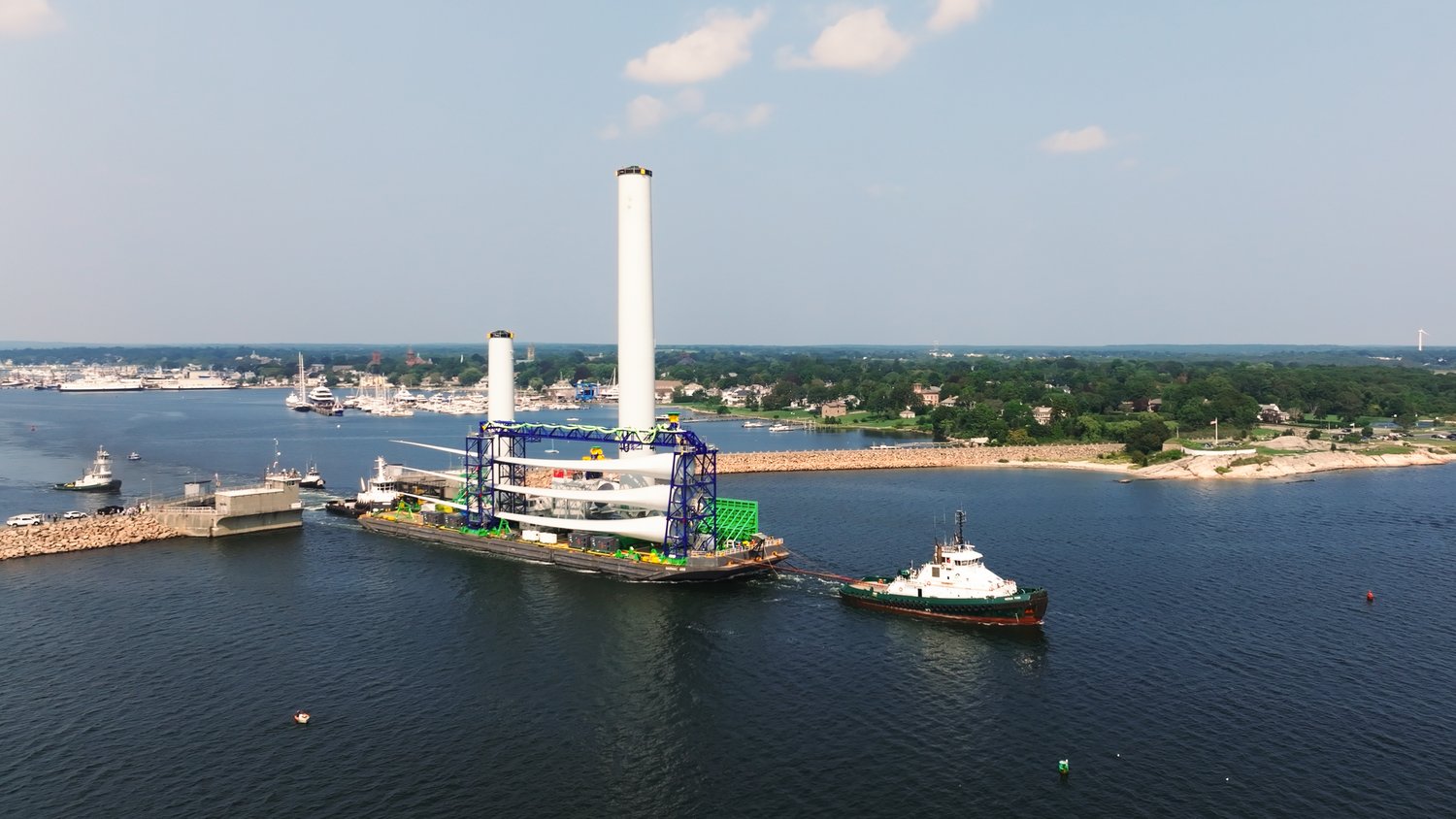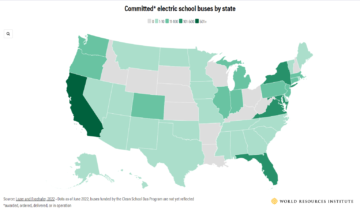Sign up for daily news updates from CleanTechnica on email. Or follow us on Google News!
Vineyard Wind, a large offshore wind farm project that has been years in the making, said it would have 5 of the 62 turbines it plans to install producing electricity by the end of 2023. It didn’t happen. Instead, a little before midnight on January 2, 2024, one turbine began sending 5 MW of power to shore, where it will help power the New England electrical grid. Project leaders chalked up the delay to a bit of bad weather, some extra precautions, and a steep learning curve, according to WBUR.
A steep learning curve, indeed! Vineyard Wind is the first large offshore wind project to start producing electricity in the United States. 5 turbines have been powering Block Island, Rhode Island since December, 2016, but they have a maximum capacity of just 30 MW and are only 4 miles offshore. Vineyard Wind, once completed, will supply up to 800 MW of power when all 62 of its turbines are installed and operational.
Offshore Wind And The Pandemic
Offshore wind has struggled to gain traction in the US, although is it commonplace in other countries. There has been bitter opposition to the turbines going all the way back to the Kennedy family worrying about how they would disturb their view of the ocean from their compound in Hyannis on Cape Cod. Several big projects were in the works when Covid hit. The pandemic wreaked havoc on the supply chain for offshore wind and, just when things started to get back to normal, interest rates shot up, making many projects that had been planned years earlier no longer viable.
Last year, the residents of Cape May, New Jersey celebrated when a project that would have been so far out to sea it would be invisible from shore was cancelled, partly because the locals feared it would ruin the tourist trade. Developers of four offshore wind projects for New York State said they needed to renegotiate their contracts. Just last week the Empire Wind 2 project in New York was scrapped by its owners, BP and Equinor. “In a nutshell,” TechCrunch says, “commercial scale offshore wind projects take a long time to come online. Projects planned before the pandemic look a lot less feasible now than they once did, as far as costs and rates go.”

WBUR reports that Amy Boyd Rabin of the Environmental League of Massachusetts is celebrating the start of operations by Vinyard Wind. Getting to the point where big offshore wind projects are generating power on the East Coast “was not inevitable” and should be celebrated “as a very big deal,” she said.
“This truly is a milestone for offshore wind and the entire renewable industry in North America. For the first time we have power flowing to the American consumers from a commercial scale wind project, which marks the dawn of a new era for American renewables and the green transition,” said Tim Evans of Copenhagen Infrastructure Partners, which is co-developing Vineyard Wind with Avangrid.
“As the first-in-the-nation project, there’s a standard of care we wanted to meet. There was testing. There were issues that had to get resolved,” said Ken Kimmell, chief development officer for Avangrid. He said it didn’t matter if the power started in the 2023 calendar year or a few days later. “The important thing is it happened and we’re now on a path to operating this facility.” Vineyard Wind hopes to have all 62 of its 800 foot high turbines, spaced about a mile apart, installed and operational by the end of 2024. The electricity they produce will be enough to power 400,000 homes in New England.
“We’ve arrived at a watershed moment for climate action in the US and a dawn for the American offshore wind industry,” wrote Avangrid CEO Pedro Azagra. “2023 was a historic year defined by steel in the water and people at work. Today, we begin a new chapter and welcome 2024 by delivering the first clean offshore wind power to the grid in Massachusetts.”
The US still has a long way to go to reach President Biden’s goal of getting 30,000 MW of offshore wind power flowing into the grid by 2030. Meeting this target, the administration says, will provide clean electricity for 10 million homes, avoid 78 million metric tons of carbon emissions and create thousands of jobs.
While states along the Atlantic coast have aspirations to install as much as 30,000 MW of offshore wind, the amount of power actually in the permitting or construction pipeline is much smaller. Over the last few months, global economic problems have caused several developers to back out of project contracts or cancel projects all together.
“No one has said that building up this industry was going to be easy. And it turns out that it’s not,” Rebecca Tepper, Massachusetts’ top energy official, said at a recent conference about offshore wind. “Despite the challenges that we face, we are confident that we will have a vibrant offshore wind industry off the coast of Massachusetts. Today, we see the promise of that industry in the Vineyard Wind Project.”
Massachusetts, in partnership with Rhode Island and Connecticut, is currently seeking bids for another 3,600 megawatts of offshore wind power. Tepper said that Vineyard Wind’s launch should boost confidence in the region’s commitment to offshore wind, and perhaps prompt “some really good bids at the end of the month. I remember talking to developers after Cape Wind (an earlier offshore wind project that failed) and thinking about whether this industry would ever get off the ground,” Tepper said. “Well, this project — Vineyard Wind — is proof that it’s off the ground and in the water.”
Fossil Fuels Fight Back Ferociously
Even now, Vineyard Wind is still facing opposition from the fishing industry, whose members worry the turbines will alter the ocean ecosystem and threaten their livelihood. To date, there are two lawsuits from fishing groups about Vineyard Wind currently winding their way through the federal court system. One of the groups is funded by the Texas Public Policy Foundation, a conservative think tank with strong ties to the fossil fuel industry.
In May 2021, Vineyard Wind 1 became the first US project to get full federal approval. A few months later, the project secured financing and began construction on land. Offshore construction, including the process of laying miles of undersea electrical cables from the project site to Covell’s Beach on Cape Cod, began in 2022. The work to install the remaining 57 turbines will continue into 2024.
“This is a historic moment for the American offshore wind industry,” wrote Gov. Maura Healey. “This is clean, affordable energy made possible by the many advocates, public servants, union workers, and business leaders who worked for decades to accomplish this achievement. As we look ahead, Massachusetts is on a path toward energy independence thanks to our nation-leading work to stand up the offshore wind industry.”
Have a tip for CleanTechnica? Want to advertise? Want to suggest a guest for our CleanTech Talk podcast? Contact us here.
Our Latest EVObsession Video
[embedded content]
I don’t like paywalls. You don’t like paywalls. Who likes paywalls? Here at CleanTechnica, we implemented a limited paywall for a while, but it always felt wrong — and it was always tough to decide what we should put behind there. In theory, your most exclusive and best content goes behind a paywall. But then fewer people read it!! So, we’ve decided to completely nix paywalls here at CleanTechnica. But…
Thank you!
Advertisement
CleanTechnica uses affiliate links. See our policy here.
- SEO Powered Content & PR Distribution. Get Amplified Today.
- PlatoData.Network Vertical Generative Ai. Empower Yourself. Access Here.
- PlatoAiStream. Web3 Intelligence. Knowledge Amplified. Access Here.
- PlatoESG. Carbon, CleanTech, Energy, Environment, Solar, Waste Management. Access Here.
- PlatoHealth. Biotech and Clinical Trials Intelligence. Access Here.
- Source: https://cleantechnica.com/2024/01/04/first-vineyard-wind-turbine-now-producing-power/
- :has
- :is
- :not
- :where
- $10 million
- $UP
- 000
- 1
- 10
- 15%
- 2016
- 2021
- 2022
- 2023
- 2024
- 2030
- 30
- 36
- 400
- a
- About
- accomplish
- achievement
- Action
- actually
- administration
- Advertise
- advocates
- Affiliate
- affordable
- After
- ahead
- All
- along
- Although
- always
- america
- American
- amount
- amy
- an
- and
- Another
- apart
- approval
- ARE
- arrived
- AS
- At
- avoid
- back
- Bad
- BE
- Beach
- became
- because
- been
- before
- began
- begin
- behind
- BEST
- Big
- Bit
- Block
- boost
- BP
- Building
- business
- Business Leaders
- but
- by
- cables
- Calendar
- Capacity
- cape
- carbon
- carbon emissions
- care
- caused
- celebrated
- Celebrating
- ceo
- chain
- challenges
- Chapter
- chief
- chip
- clean
- cleantech
- Cleantech Talk
- Climate
- climate action
- Coast
- CoD
- come
- commercial
- commitment
- Companies
- Completed
- completely
- Compound
- Conference
- confidence
- confident
- Connecticut
- conservative
- construction
- Consumers
- content
- continue
- contracts
- Copenhagen
- Costs
- countries
- Court
- Covid
- create
- Currently
- curve
- Date
- Days
- deal
- decades
- December
- decide
- decided
- defined
- delay
- delivering
- developers
- Development
- DID
- don
- Earlier
- East
- east coast
- easy
- Economic
- ecosystem
- electricity
- embedded
- Emissions
- Empire
- end
- energy
- England
- enough
- Entire
- environmental
- Equinor
- Era
- EVER
- Exclusive
- extra
- Face
- Facility
- facing
- Failed
- family
- far
- farm
- feasible
- Federal
- felt
- few
- fewer
- fight
- fight back
- financing
- First
- first time
- Fishing
- Flowing
- Foot
- For
- fossil
- Fossil fuel
- Foundation
- four
- from
- Fuel
- fuels
- full
- funded
- Gain
- generating
- get
- getting
- Global
- Global Economic
- Go
- goal
- Goes
- going
- good
- Green
- Grid
- Ground
- Group’s
- Guest
- had
- happen
- happened
- Have
- he
- help
- here
- High
- historic
- Hit
- Homes
- hopes
- How
- HTTPS
- i
- if
- implemented
- important
- in
- In other
- Including
- independence
- industry
- Infrastructure
- install
- installed
- instead
- interest
- Interest Rates
- into
- invisible
- island
- issues
- IT
- ITS
- January
- Jobs
- jpg
- just
- Land
- large
- Last
- later
- latest
- launch
- Lawsuits
- laying
- leaders
- League
- learning
- less
- like
- likes
- Limited
- links
- little
- Long
- long time
- longer
- Look
- Lot
- made
- Making
- many
- massachusetts
- Matter
- max-width
- maximum
- May..
- Media
- Meet
- meeting
- Members
- metric
- midnight
- milestone
- million
- moment
- Month
- months
- most
- much
- Need
- needed
- New
- New York
- New York state
- news
- no
- normal
- North
- north america
- now
- Nutshell
- ocean
- of
- off
- Officer
- official
- on
- once
- ONE
- online
- only
- operating
- operational
- Operations
- opposition
- or
- Other
- our
- out
- over
- owners
- pandemic
- partners
- Partnership
- path
- People
- perhaps
- pipeline
- planned
- plans
- plato
- Plato Data Intelligence
- PlatoData
- player
- podcast
- Point
- policy
- possible
- power
- Powering
- president
- problems
- process
- produce
- producing
- project
- projects
- promise
- proof
- provide
- public
- publish
- put
- Rates
- reach
- Read
- Reader
- really
- recent
- remaining
- remember
- Renewable
- Renewables
- Reports
- residents
- resolved
- ruin
- Said
- says
- Scale
- SEA
- Secured
- see
- seeking
- sending
- servants
- several
- she
- shot
- should
- since
- site
- smaller
- So
- so Far
- some
- stand
- standard
- start
- started
- State
- States
- steel
- Still
- Stories
- strong
- suggest
- supply
- supply chain
- support
- system
- T
- Take
- Talk
- talking
- tank
- Target
- team
- Testing
- texas
- than
- thanks
- that
- The
- their
- then
- theory
- There.
- they
- thing
- things
- Think
- think tank
- Thinking
- this
- thousands
- threaten
- Through
- Ties
- Tim
- time
- tip
- to
- today
- together
- tons
- top
- tough
- toward
- traction
- trade
- transition
- truly
- turbine
- turns
- two
- union
- United
- United States
- Updates
- us
- uses
- Ve
- very
- viable
- vibrant
- Video
- View
- want
- wanted
- was
- Water
- Way..
- we
- Weather
- week
- welcome
- were
- What
- when
- whether
- which
- while
- WHO
- whose
- will
- wind
- wind power
- wind turbine
- with
- Work
- worked
- workers
- works
- worry
- worrying
- would
- write
- Wrong
- wrote
- year
- years
- york
- you
- Your
- youtube
- zephyrnet





